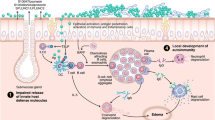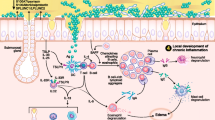Abstract
Chronic rhinosinusitis (CRS) is a heterogeneous inflammatory condition with a multifactorial basis. Infectious triggers of CRS have been proposed, but demonstration remains elusive. Evolving research suggests that abnormal host mucosal immune responses, rather than specific pathogens themselves, may underlie the chronic inflammatory state. Despite constant contact with airborne particulates and microorganisms, the sinonasal epithelium maintains mucosal homeostasis through innate and adaptive immune mechanisms that eliminate potential threats. Innate immunity encompasses a broad collection of constitutive and inducible processes that can be nonspecific or pathogen directed. Some innate immune pathways are closely intertwined with tissue growth and repair. The persistent inflammation observed in CRS may result from a pathologic imbalance in innate immune interactions between the host and the environment. Impairment of critical innate immune protection renders the sinonasal mucosal surface susceptible to colonization and potential injury, stimulating the prominent adaptive immune response that characterizes CRS.
Similar content being viewed by others
References and Recommended Reading
Knowles MR, Boucher RC: Mucus clearance as a primary innate defense mechanism for mammalian airways. J Clin Invest 2002, 109:571–577.
Basu S, Fenton MJ: Toll-like receptors: function and roles in lung disease. Am J Physiol Lung Cell Mol Physiol 2004, 286:L887–L892.
Medzhitov R, Preston-Hurlburt P, Janeway CA Jr: A human homologue of the Drosophila Toll protein signals activation of adaptive immunity. Nature 1997, 388:394–397.
Janssens S, Beyaert R: Role of Toll-like receptors in pathogen recognition. Clin Microbiol Rev 2003, 16:637–646.
Lindahl M, Stahlbom B, Tagesson C: Newly identified proteins in human nasal and bronchoalveolar lavage fluids: potential biomedical and clinical applications. Electrophoresis 1999, 20:3670–3676.
Lee SH, Kim JE, Lim HH, et al.: Antimicrobial defensin peptides of the human nasal mucosa. Ann Otol Rhinol Laryngol 2002, 111:135–141.
Ellison RT 3rd, Giehl TJ: Killing of gram-negative bacteria by lactoferrin and lysozyme. J Clin Invest 1991, 88:1080–1091.
Kuwata H, Yip TT, Yip CL, et al.: Bactericidal domain of lactoferrin: detection, quantitation, and characterization of lactoferricin in serum by SELDI affinity mass spectrometry. Biochem Biophys Res Commun 1998, 245:764–773.
Zhu J, Nathan C, Ding A: Suppression of macrophage responses to bacterial lipopolysaccharide by a non-secretory form of secretory leukocyte protease inhibitor. Biochim Biophys Acta 1999, 1451:219–223.
Aho HJ, Grenman R, Sipila J, et al.: Group II phospholipase A2 in nasal fluid, mucosa and paranasal sinuses. Acta Otolaryngol 1997, 117:860–863.
Sorensen OE, Follin P, Johnsen AH, et al.: Human cathelicidin, hCAP-18, is processed to the antimicrobial peptide LL-37 by extracellular cleavage with proteinase 3. Blood 2001, 97:3951–3959.
Vonk MJ, Hiemstra PS, Grote JJ: An antimicrobial peptide modulates epithelial responses to bacterial products. Laryngoscope 2008, 118:816–820.
Lehrer RI, Lichtenstein AK, Ganz T: Defensins: antimicrobial and cytotoxic peptides of mammalian cells. Annu Rev Immunol 1993, 11:105–128.
Claeys S, de Belder T, Holtappels G, et al.: Human beta-defensins and Toll-like receptors in the upper airway. Allergy 2003, 58:748–753.
Woodworth BA, Lathers D, Neal JG, et al.: Immunolocalization of surfactant protein A and D in sinonasal mucosa. Am J Rhinol 2006, 20:461–465.
Sha Q, Truong-Tran AQ, Plitt JR, et al.: Activation of airway epithelial cells by Toll-like receptor agonists. Am J Respir Cell Mol Biol 2004, 31:358–364.
Lane AP, Truong-Tran QA, Myers A, et al.: Serum amyloid A, properdin, complement 3, and Toll-like receptors are expressed locally in human sinonasal tissue. Am J Rhinol 2006, 20:117–123.
Polito AJ, Proud D: Epithelia cells as regulators of airway inflammation. J Allergy Clin Immunol 1998, 102:714–718.
Kaliner MA: Human nasal host defense and sinusitis. J Allergy Clin Immunol 1992, 90:424–430.
Kim CH, Kim K, Jik Kim H, et al.: Expression and regulation of PLUNC in human nasal epithelium. Acta Otolaryngol 2006, 126:1073–1078.
Heinecke L, Proud D, Sanders S, et al.: Induction of B7-H1 and B7-DC expression on airway epithelial cells by the Tolllike receptor 3 agonist double-stranded RNA and human rhinovirus infection: in vivo and in vitro studies. J Allergy Clin Immunol 2008, 121:1155–1160.
Chong KT, Thangavel RR, Tang X: Enhanced expression of murine beta-defensins (MBD-1, -2,-3, and -4) in upper and lower airway mucosa of influenza virus infected mice. Virology 2008, 380:136–143.
Yamin M, Holbrook EH, Gray ST, et al.: Cigarette smoke combined with Toll-like receptor 3 signaling triggers exaggerated epithelial regulated upon activation, normal T-cell expressed and secreted/CCL5 expression in chronic rhinosinusitis. J Allergy Clin Immunol 2008, 122:1145–1153.
MacRedmond RE, Greene CM, Dorscheid DR, et al.: Epithelial expression of TLR4 is modulated in COPD and by steroids, salmeterol and cigarette smoke. Respir Res 2007, 8:84.
Lee WK, Ramanathan M Jr, Spannhake EW, Lane AP: The cigarette smoke component acrolein inhibits expression of the innate immune components IL-8 and human betadefensin 2 by sinonasal epithelial cells. Am J Rhinol 2007, 21:658–663.
Van Bruaene N, Perez-Novo CA, Basinski TM, et al.: T-cell regulation in chronic paranasal sinus disease. J Allergy Clin Immunol 2008, 121:1435–1441.
Li HB, Cai KM, Liu Z, et al.: Foxp3+ T regulatory cells (Tregs) are increased in nasal polyps (NP) after treatment with intranasal steroid. Clin Immunol 2008, 129:394–400.
Kato A, Peters A, Suh L, et al.: Evidence of a role for B cell-activating factor of the TNF family in the pathogenesis of chronic rhinosinusitis with nasal polyps. J Allergy Clin Immunol 2008, 121:1385–1392.
Sauer J, Damm M, Rosenbohm J, Jurk T: Gene expression of thymic stromal lymphopoietin in nasal mucosa and nasal polyps. Otolaryngol Head Neck Surg 2004, 131:P190.
Kim TH, Lee SH, Lee HM, et al.: Increased expression of glycoprotein 340 in the ethmoid sinus mucosa of patients with chronic sinusitis. Arch Otolaryngol Head Neck Surg 2007, 133:1111–1114.
Berger G, Kogan T, Ophir D, et al.: Glycoconjugate expression of sinus mucosa in chronic rhinosinusitis: a lectin histochemical study. Am J Rhinol 2008, 22:349–355.
Ding GQ, Zheng CQ: The expression of MUC5AC and MUC5B mucin genes in the mucosa of chronic rhinosinusitis and nasal polyposis. Am J Rhinol 2007, 21:359–366.
Viswanathan H, Brownlee IA, Pearson JP, Carrie S: MUC5B secretion is up-regulated in sinusitis compared with controls. Am J Rhinol 2006, 20:554–557.
Woo HJ, Min JK, Bai CH, et al.: Expression of neutrophil gelatinase-associated lipocalin in nasal polyps. Arch Otolaryngol Head Neck Surg 2008, 134:1182–1186.
Ooi EH, Wormald PJ, Carney AS, et al.: Human cathelicidin antimicrobial peptide is up-regulated in the eosinophilic mucus subgroup of chronic rhinosinusitis patients. Am J Rhinol 2007, 21:395–401.
Kim ST, Cha HE, Kim DY, et al.: Antimicrobial peptide LL-37 is upregulated in chronic nasal inflammatory disease. Acta Otolaryngol 2003, 123:81–85.
Ooi EH, Wormald PJ, Carney AS, et al.: Surfactant protein D expression in chronic rhinosinusitis patients and immune responses in vitro to Aspergillus and alternaria in a nasal explant model. Laryngoscope 2007, 117:51–57.
Ooi EH, Wormald PJ, Carney AS, et al.: Fungal allergens induce cathelicidin LL-37 expression in chronic rhinosinusitis patients in a nasal explant model. Am J Rhinol 2007, 21:367–372.
Lane AP, Truong-Tran QA, Schleimer RP: Altered expression of genes associated with innate immunity and inflammation in recalcitrant rhinosinusitis with polyps. Am J Rhinol 2006, 20:138–144.
Ramanathan M Jr, Lee WK, Dubin MG, et al.: Sinonasal epithelial cell expression of Toll-like receptor 9 is decreased in chronic rhinosinusitis with polyps. Am J Rhinol 2007, 21:110–116.
Ramanathan M Jr, Spannhake EW, Lane AP: Chronic rhinosinusitis with nasal polyps is associated with decreased expression of mucosal interleukin 22 receptor. Laryngoscope 2007, 117:1839–1843.
Ramanathan M Jr, Lee WK, Spannhake EW, Lane AP: Th2 cytokines associated with chronic rhinosinusitis with polyps down-regulate the antimicrobial immune function of human sinonasal epithelial cells. Am J Rhinol 2008, 22:115–121.
Ferguson BJ, Seethala R, Wood WA: Eosinophilic bacterial chronic rhinosinusitis. Laryngoscope 2007, 117:2036–2040.
Olze H, Forster U, Zuberbier T, et al.: Eosinophilic nasal polyps are a rich source of eotaxin, eotaxin-2 and eotaxin-3. Rhinology 2006, 44:145–150.
Lezcano-Meza D, Davila-Davila B, Vega-Miranda A, et al.: Interleukin (IL)-4 and to a lesser extent either IL-13 or interferon-gamma regulate the production of eotaxin-2/CCL24 in nasal polyps. Allergy 2003, 58:1011–1017.
Ramanathan M Jr, Lee WK, Lane AP: Increased expression of acidic mammalian chitinase in chronic rhinosinusitis with nasal polyps. Am J Rhinol 2006, 20:330–335.
Laleker A, Nkrumah L, Lee WK, et al.: Chitin stimulates expression of acidic mammalian chitinase and eotaxin 3 by human sinonasal epithelial cells in vitro. Am J Rhinol 2009 (in press).
Hartl D, He CH, Koller B, et al.: Acidic mammalian chitinase is secreted via an ADAM17/EGFR-dependent pathway and stimulates chemokine production by pulmonary epithelial cells. J Biol Chem 2008, 283:33472–33482.
Rudack C, Steinhoff M, Mooren F, et al.: PAR-2 activation regulates IL-8 and GRO-alpha synthesis by NF-kappaB, but not RANTES, IL-6, eotaxin or TARC expression in nasal epithelium. Clin Exp Allergy 2007, 37:1009–1022.
Richer SL, Truong-Tran AQ, Conley DB, et al.: Epithelial genes in chronic rhinosinusitis with and without nasal polyps. Am J Rhinol 2008, 22:228–234.
Nonaka M, Ogihara N, Fukumoto A, et al.: Toll-like receptor 2, 3, 4, 5 ligands and interleukin-4 synergistically induce TARC production in nasal polyp fibroblasts. Auris Nasus Larynx 2008, 35:515–520.
Fukumoto A, Nonaka M, Ogihara N, Pawankar R: Induction of TARC production by lipopolysaccharide and interleukin-4 in nasal fibroblasts. Int Arch Allergy Immunol 2008, 145:291–297.
Nonaka M, Ogihara N, Fukumoto A, et al.: Combined stimulation of nasal polyp fibroblasts with poly IC, interleukin 4, and tumor necrosis factor alpha potently induces production of thymus- and activation-regulated chemokine. Arch Otolaryngol Head Neck Surg 2008, 134:630–635.
Koff JL, Shao MX, Ueki IF, Nadel JA: Multiple TLRs activate EGFR via a signaling cascade to produce innate immune responses in airway epithelium. Am J Physiol Lung Cell Mol Physiol 2008, 294:L1068–L1075.
Burgel PR, Nadel JA: Epidermal growth factor receptormediated innate immune responses and their roles in airway diseases. Eur Respir J 2008, 32:1068–1081.
Ding GQ, Zheng CQ, Bagga SS: Up-regulation of the mucosal epidermal growth factor receptor gene in chronic rhinosinusitis and nasal polyposis. Arch Otolaryngol Head Neck Surg 2007, 133:1097–1103.
Chen B, Shaari J, Claire SE, et al.: Altered sinonasal ciliary dynamics in chronic rhinosinusitis. Am J Rhinol 2006, 20:325–329.
Hunsaker DH, Leid JG: The relationship of biofilms to chronic rhinosinusitis. Curr Opin Otolaryngol Head Neck Surg 2008, 16:237–241.
Psaltis AJ, Wormald PJ, Ha KR, Tan LW: Reduced levels of lactoferrin in biofilm-associated chronic rhinosinusitis. Laryngoscope 2008, 118:895–901.
Author information
Authors and Affiliations
Corresponding author
Rights and permissions
About this article
Cite this article
Lane, A.P. The role of innate immunity in the pathogenesis of chronic rhinosinusitis. Curr Allergy Asthma Rep 9, 205–212 (2009). https://doi.org/10.1007/s11882-009-0030-5
Published:
Issue Date:
DOI: https://doi.org/10.1007/s11882-009-0030-5




